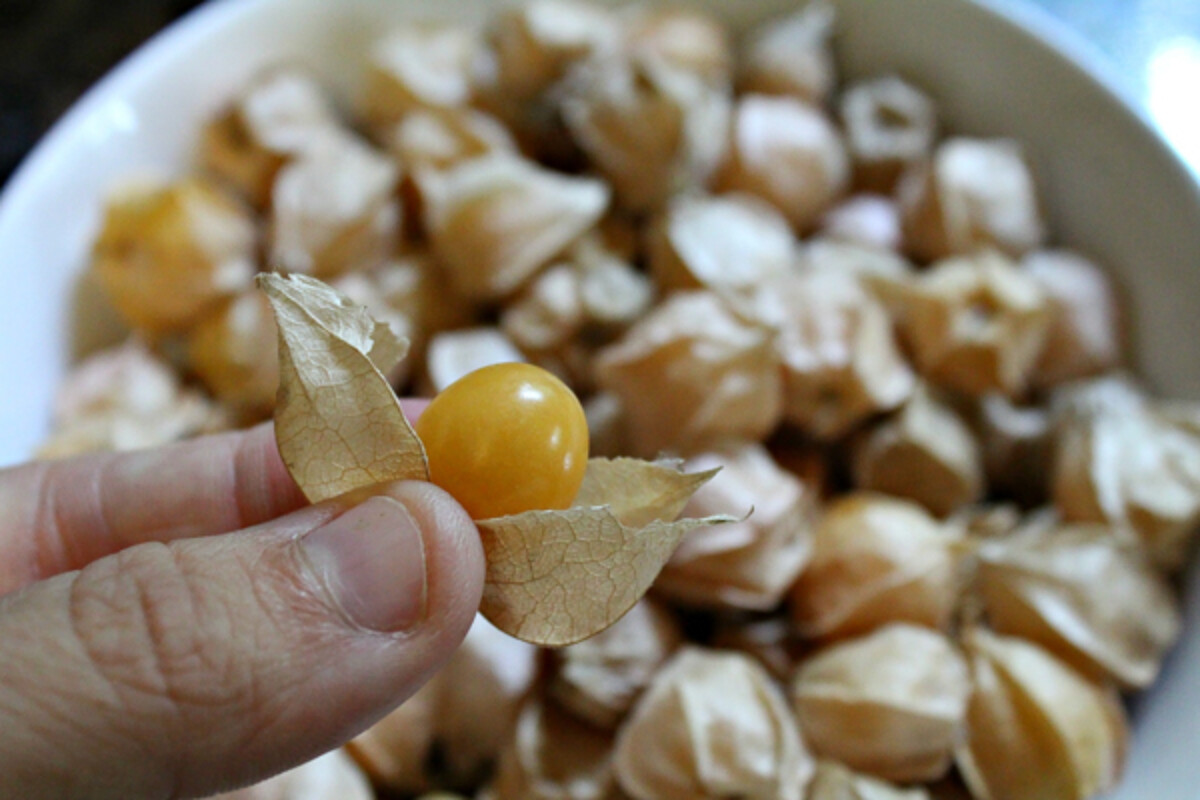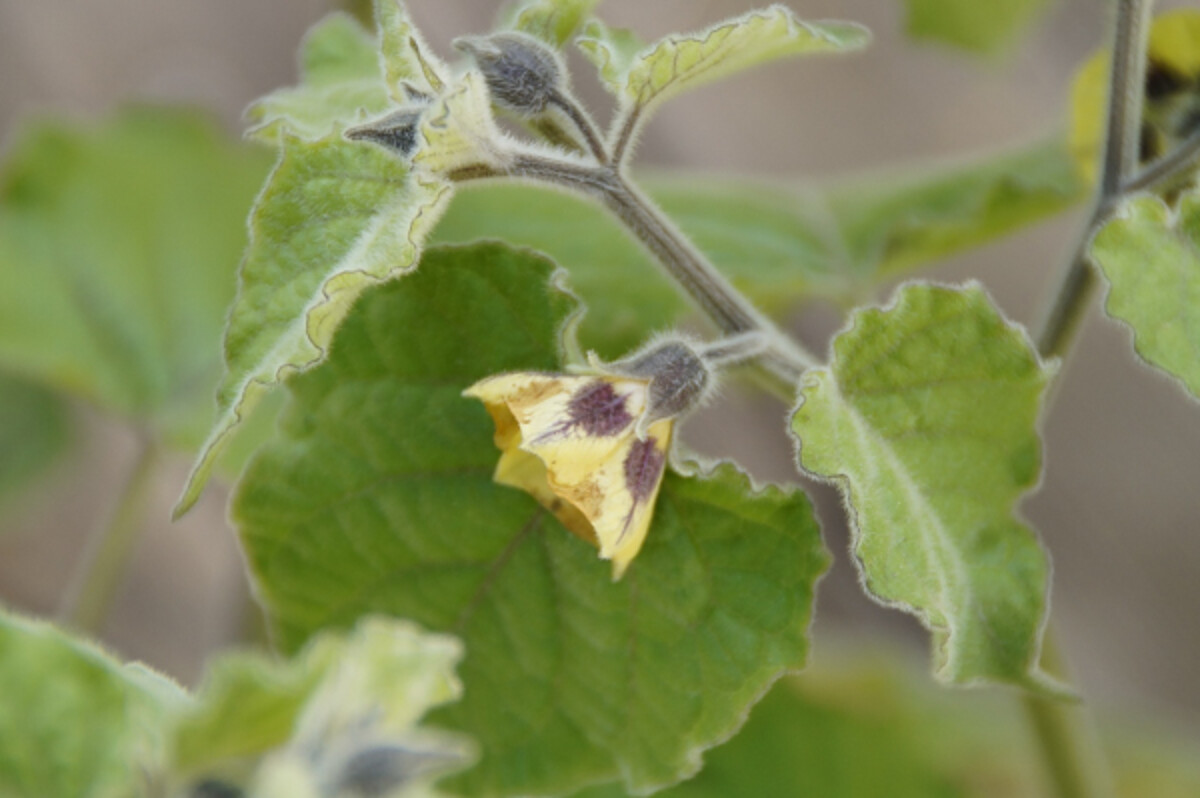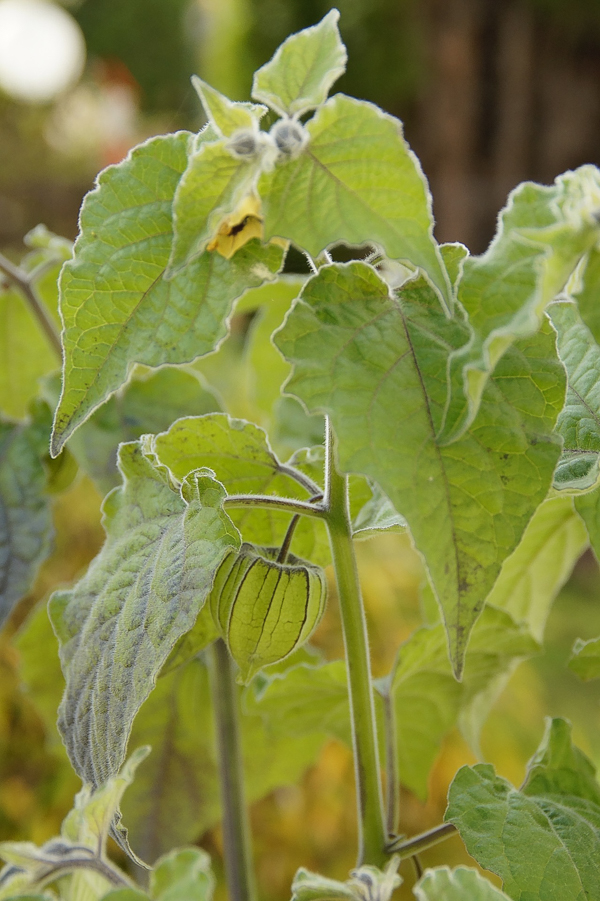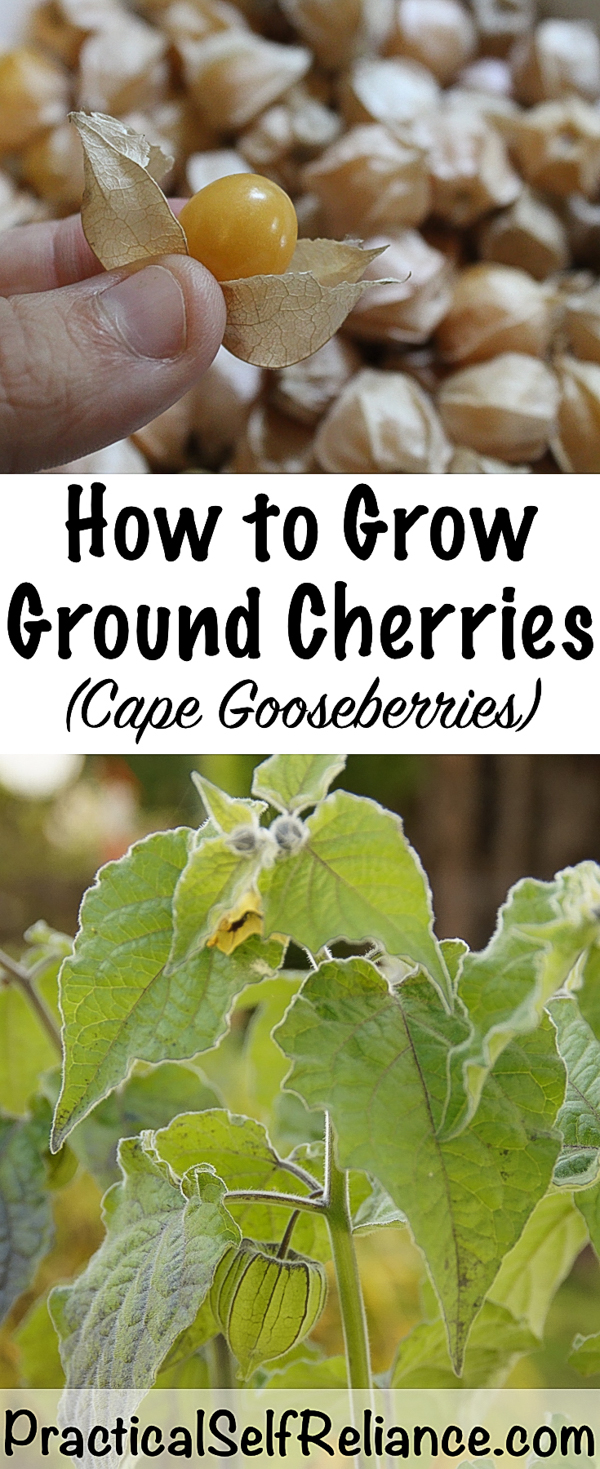Affiliate disclosure: This post may contain affiliate links. Please see our Privacy Policy.
My first exposure to ground cherries was in Vermont. I was selling baked goods at a farmers market, and a young girl walked up and asked if I wanted to trade. Sure why not?
She ran back home and brought back a container full of small orange lantern-like fruits. She unwrapped one and offered it to me.
After one taste I was hooked. She took home a full double-layer celebration cake in exchange, and I think I got the better end of the deal.

Table of Contents
- Types of Ground Cherries
- Strawberry Ground Cherry (Physalis pruinosa)
- Cape Gooseberry (Physalis peruviana)
- Pineapple Ground Cherry (Physalis pubescens)
- Thick Leafed Ground Cherry (Physalis crassifolia)
- Growing Ground Cherries from Seed
- Growing Ground Cherry Plants
- Where to Buy Ground Cherries
- Ways to Use Ground Cherries
Ground Cherries (Physalis species), are also known as cape gooseberries, husk tomatoes, sweet tomatillos and poha berry. Each different variety has its own unique taste, but for the most part, they taste like a cross between pineapple, citrus, and strawberries. They have a bright, sweet flavor like a pineapple with subtle strawberry undertones.
There are many different types of husk cherry, and some of those “common names” actually refer to distinct cultivars. Cape gooseberries, for example, are a specific type of ground cherry that’s native to Peru (Physalis peruviana) that was introduced to the cape of good hope, where it became quite popular. Thus the name “cape gooseberry,” even though they’re not related to gooseberries at all.
There are a number of ground cherry species that are native throughout the United States. Where they’re not native, varieties were introduced by early settlers.
Most fruits, like apples and peaches, can take 7 to 10 years to begin to bear fruit. Ground cherries were a way to harvest fruit in the same year that settlers put down roots. They take about 70 days from seed to first fruit, which made them popular in the kitchen gardeners of settlers and homesteaders.
Types of Ground Cherries
Ground cherries are a member of the Physalis genus, which also includes other plants with a distinctive paper husk such as Chinese paper lanterns and tomatillos. Ground cherries are in the nightshade family, which includes tomatoes. Though some varieties go by the name “cape gooseberries,” they’re not actually related to gooseberries.
Strawberry Ground Cherry (Physalis pruinosa)
Strawberry ground cherries are the most common type of ground cherries in the united states. A polish heirloom, called “Aunt Molly’s Ground Cherry” is the variety grown by most backyard gardeners these days. You can find strawberry ground cherry seeds here.
Common varieties of Physalis pruinosa include:
- Aunt Molly’s Ground Cherry – 70 days to maturity. A polish heirloom that tastes like citrus. Brought to Pennsylvania by polish immigrants in the early 1800s. Fruits are roughly 3/4 inch in diameter, and plants grow to about 2 1/2 feet tall.
- Yellow Husk – Similar to Aunt Mollys, but with slightly smaller plants growing 1 1/2 to 2 feet tall.
Cape Gooseberry (Physalis peruviana)
This variety goes by the name Peruvian ground cherry and cape gooseberry because it was grown in the cape of good hope by settlers to South Africa. This variety is considerably rarer, but you can find Peruvian ground cherry seeds here.
- Cape gooseberry or Goldenberry – This species grows extra-large, with plants reaching 4 feet tall. Production is not as heavy as other varieties, and they tend to ripen later than others. Grows as a perennial in zone 8 and above. Fruits are larger than other varieties, roughly 1 inch in diameter. This variety is often dried into “ground cherry raisins.”
Pineapple Ground Cherry (Physalis pubescens)
A close relative of the Peruvian ground cherry. This species stores particularly well and may keep for months in the husk without special treatment.
- Goldie Ground Cherry – 75 days to maturity. Produces heavy yields of bight gold fruit. Large plants grow 3 to 4 feet tall.
- Cossack Pineapple Ground Cherry – 75 days to maturity. Tastes like a tart/sweet pineapple. This variety stores particularly well.
- Yantar Ground Cherry – This variety is was developed in Russia, and only grows from 6 to 18” tall. It’s very rare, and hard to find seed for this dwarf variety.
Thick Leafed Ground Cherry (Physalis crassifolia)
A species of ground cherry native to the American Southwest.
- Yellow Nightshade Ground Cherry – A relatively rare variety, not commonly cultivated, but seeds can occasionally be found. Plants are small, growing 1 to 1 1/2 feet tall.
Though these seem to be the most common varieties, there are dozens of species of sweet physalis, native to just about everywhere in the world.

Growing Ground Cherries from Seed
Ground cherries sprout readily from seed, and will often self-sow.
Start husk cherries indoors, about 6 to 8 weeks before the last frost date. In some areas, you can find ground cherry plants for transplant, and our local co-op sells them alongside tomatillos and tomatoes for home gardeners.
On average, ground cherry seeds take 7 to 14 days to germinate at 65 degrees. The plants reach maturity at 70 days and will begin producing large crops of fruit right up until the first frost. We grow them successfully in our short 100 day growing season, but it always seems like they’re just coming into peak production when the first frost hits.
Ground cherries can be grown as perennials in zone 8 or above.

Growing Ground Cherry Plants
Ground cherries grow upright with stiff stems, sometimes reaching 3 feet in height in a single growing season. They often topple over under the weight of fruit, so some type of support like a peony cage or large tomato cage helps keep them producing, and prevents broken branches.
In ideal conditions, ground cherries prefer humus-rich, moist, well-drained soil. They have a weedy nature, and practically speaking, they’ll grow just about anywhere. That said, they don’t do well in soggy or poorly drained soils.
Ground cherries produce hundreds of small yellow flowers per plant. If those flowers are pollinated, they’ll develop into small marble-sized fruits that are wrapped in a papery husk. The husk remains green while the husk cherries are developing, and turns to a golden yellow color once the fruit has ripened.
The plants are prolific, producing several quarts of fruit from a single plant. A small family would have plenty to eat and preserve with just 2 to 3 plants.
They take well to containers, so they’re a good choice for urban gardeners.

Ground cherries will keep for months if they’re handled gently and not removed from their husks. I’ve had fresh husk cherries on the table at Thanksgiving, about 2 months after the first frost here in Vermont.
The husks slowly disintegrate, leaving a delicate mesh that’s quite beautiful. After a month or so, ground cherry fruits will still be protected in their husks, but their husks will have transformed into transparent nets around each individual fruit.
Where to Buy Ground Cherries
Ground cherries are becoming quite popular at farmers’ markets and you can occasionally find them in a CSA basket. Grocery stores are selling them out of the husk and in tiny plastic clamshells, under the name “Goldenberry.” When we found them at our local grocery store, they were packaged by Sunkist.
You can find dried ground cherry “raisins” sold as goldenberries here.
They’re also being marketed in the frozen fruit section, as a new “superfood” under the name pichuberry. Retailers like Walmart have them, or you can buy pichuberry here.
Ways to Use Ground Cherries
Husk cherries are naturally high in pectin, so they make an easy pectin-free ground cherry jam or tasty ground cherry pie without any thickener. We’ve also made them into small-batch mead (honey wine).
Try any of these ground cherry recipes:















Polish is with a capital P just a Pennsylvania or Peru, lower case is pronounced differently and also has a different meaning.
Thanks for pointing that out. You will probably find typos here and there but hopefully it isn’t anything too serious.
I just purchased a home in N. Maine. The former owners had many of these plants in the raised beds. I sampled a few of the ripe fruit in Aug. & Was pleasantly surprised by the sweet, tart fruit. Luckily they self seed here, I’m told. I am harvesting the fruit & saving the seeds. So many I certainly don’t need them all. If you would like some seeds, please E-mail me at singignoli@aol.com & I will share, all I ask is you send me self addresses stamped envelope.
Not all ground cherries are Cape Gooseberry Ground Cherries, they are a seperate breed
Yes, there are common names for several different varieties listed in the post.
Not a single word on pests on this webpage.
Look very closely at your ripened Cape Gooseberry Ground Cherry fruit, if you see a tiny pinhole, cut the fruit open and find a tiny maggot growing inside. I’m looking for traps that will kill whatever these maggots are before the female lays the egg inside the fruit. Wisconsin, zone 5a, this destrution of fruits occurs in late Aug throughout September. Note The fruits that ripen late in September won’t have this maggot problem, but where I live frost becomes the killer of the plants, usally front kills the plants by October.
I have a beautiful plant, lot of flowers, I see bees on them all the time. The flowers have been showing for months, but seem to fall off, I have no fruit at all. Probably too late this year, but is there any fertilizer that might help?
It sounds like blossom drop which can also happen with tomatoes. This often occurs when temperatures are too high or when the plants are too dry. Try adding a shade cloth to give them some relief from the sun and also increase watering.
Thanks so much! I will give those ideas a try!
I love ground cherries, I was given a plant by a neighbor of my sons and enjoyed it for years. I have since moved and would love to find another plant. We called them ground tomatoes too. When ever anyone would ask what they were we would say ground cherries or ground tomatoes whatever name we could think of at that time. my grand kids could not wait for the season to change so they could go picking and eating.
Yes, ground cherries are an unknown and unappreciated fruit to many people. They’ve been a favorite in our family since I was a child in WI where they grew wild in our village gardens, likely self seeded by immigrant gardeners from Europe.. Mom would can whatever she could so we kids didn’t overeat, as they are luscious. My attempts to grow them here in northern Alabama have been frustrated by critters. They don’t wait for the husks to ripen and often I’d find a scattering of husks of all sizes. I’ve tried growing them in buckets with netting around only to find it a challenge to harvest as the plants need to be checked frequently. They don’t produce a crop all at one time, the ones I’ve grown.
lots of great information ‘about’ ground cherries.. but, unlike the title suggests.. not really any on *how* to plant them.. planting time, spacing.. thinning, feeding et al 🙂
I am an old hat at sustainable gardening (for food, teas, medicines, soap and more!) but have not grown these until just this year, and am looking for actual planting info if you have any to offer – Love & Light, Always